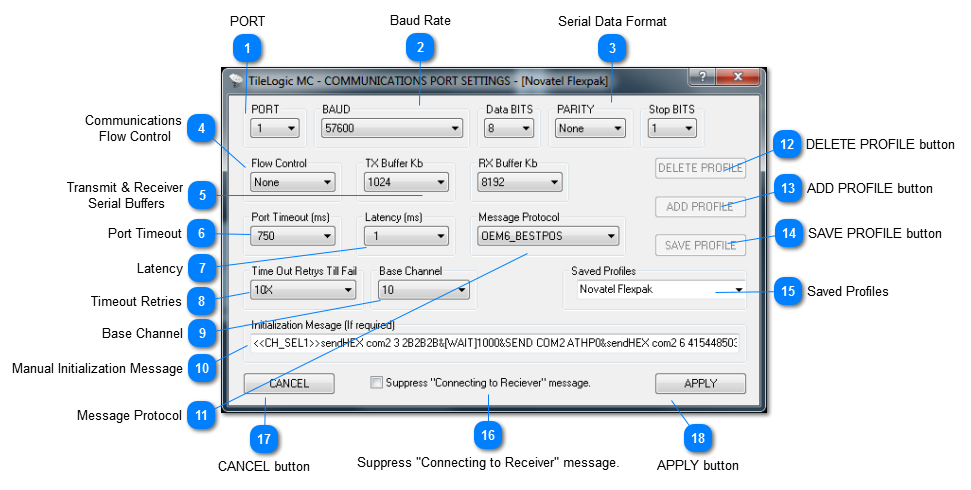COMMUNICATIONS PORT SETTINGS window
 PORT
 The physical communications port (Serial Port) that is used between GPS communications and the computer.
|
|
 Baud Rate
 The baud rate used in the communications with the GPS receiver. See the GPS receiver documentation for setting it's baud rate. The computer and receiver MUST communicate at the same rate, or garbled messages will be seen.
|
|
 Serial Data Format
Consult GPS Receiver documentation for data format settings, and set these to match.
Generally the most common settings are:
Data Bits = 8
Parity = None
Stop Bits = 1
Often, in documentation, this is expressed as "8, N, 1".
|
|
 Communications Flow Control
 Consult GPS Receiver documentation for required flow control, if any.
Options are None, Xon/Xoff (sometimes called "software flow control"), and Hardware.
Generally, set to NONE.
|
|
 Transmit & Receiver Serial Buffers
 The amount of memory to assign to the buffers for the serial port.
|
|
 Port Timeout
 When communications are lost on the serial port, this is the amount of time (milliseconds) that TileLogic waits until it tries to close, and attempt to reopen the comm port.
|
|
 Latency
 When an incomplete serial message is received, this is the amount of time TileLogic pauses, before rereading the comm port. Set this as low as possible. Only increase when comm errors are persistent.
|
|
 Timeout Retries
 The number of times TileLogic will attempt to reopen communications before "giving up".
|
|
 Base Channel
 If specified, in the Protocol.def file, a drop down which changes the base station RF channel.
|
|
 Manual Initialization Message
This displays the initialization string based on the parameters specified in the protocol.def file for base station RF channel changes.
OR
If no channel parameters are defined, the user may enter manually a temporary initialization parameter. (For advanced users.)
|
|
 Message Protocol
 Allows the user to select a protocol based on what is predefined in the Protocol.def file.
|
|
 DELETE PROFILE button
 The SELECTED profile in the Saved Profiles box will be deleted.
|
|
 ADD PROFILE button
 By typing a name into the Saved Profiles box, selecting parameters desired, and clicking on this button, and new profile will be created. Up to 10 profiles can be saved.
|
|
 SAVE PROFILE button
 When enabled, changes to the current profile will be saved, BUT NOT APPLIED.
|
|
 Saved Profiles
 Used to select a saved profile.
|
|
 Suppress "Connecting to Receiver" message.
 Whenever TileLogic attempts to establish a connection, a window appears alerting the user. To suppress this window, select this box (not recommended).
|
|
 CANCEL button
 Exit without apply or save.
|
|
 APPLY button
 Save current profile. Close, and reopen the serial port with selected parameters.
|
|


